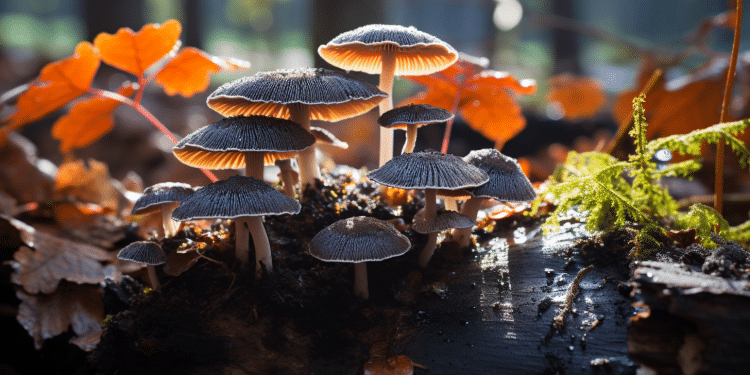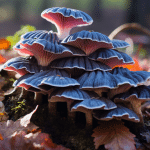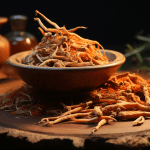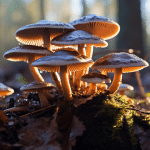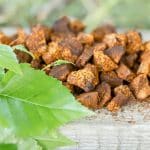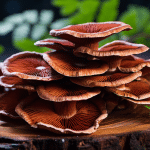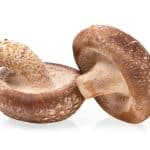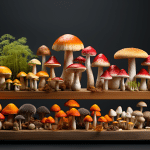Is the turkey tail mushroom poisonous? No, Turkey Tail Mushrooms are not poisonous. They actually have a lot of amazing health benefits. Which is great because this mushroom is so readily available and easy to find.
There are a surprising amount of turkey-tail copy cats and lookalikes that you’ll want to watch out for, but if you inspect them closely, you will be able to tell a real turkey tail. The turkey tail mushroom, and its 2 looks-alikes, are the most common mushrooms that you will encounter while walking through the woods, foraging, or camping.
Look-alike species As we mentioned earlier, there are A LOT of turkey tail mushroom look-alikes. Identification of turkey tail mushrooms (Trametes versicolor) is going to come in handy, as there are many look-alikes for it that are extremely similar.
Tips for Identifying Turkey Tail
The 2 that are similar are Violet Toothed Polypores (Trichaptum biforme) and False turkey tail (Stereum ostrea). The real turkey tail is white underside, with pores on its surface, which are visible with the naked eye (or, in my case, a pair of glasses). The fake turkey tail (Stereum hirsutum) is yellow, and being a crustose mushroom, is a smooth.
Another mushroom called False Turkey Tail looks similar from above, but when you turn over another mushroom, you will notice a difference, since the False Turkey Tail has a smooth underside. This mushroom looks like turkey tails from the top in that it has concentric zones of multiple colors, however, the colors are a bit muted as it will mostly be white, gray, and some brown. If your mushroom has a smooth lower part, or the pores are big and easily visible, you have a different species than turkey tail.
Similar-looking mushrooms that do not show any drastic bands – the colors are more or less all the same, with just slight variations, then you likely have a different species. Most of the other species of Trametes will be a grayer looking species with no colorful bands like the real turkey tail. Looking at photos of other similar looking turkey tails, they appear to be a lot more furry, and solid colors really help to differentiate these trametes species.
More Turkey Tail Look-alikes
Another similar looking turkey tail, known as Hairy bracket mushroom (Trametes hirsuta), looks very similar to the turkey tail mushrooms, but instead of having surface colors from the striping rings, it is mainly white-ish or grayish. As if this was not confusing enough on the field, the non-commonly named Trichaptum abietinum looks somewhat like faded turkey tail, with a bit of washed-out color variation and zoned growth. Other mushrooms, such as Trichaptum abietinum or Lenzite betulina, look similar to turkeys tails at first sight. T. pubescens is generally larger than a turkey tail too (but not always) and is most commonly found either alone, or in smaller groups not tightly overlapped.
More Info on Turkey Tail
The turkey tail mushroom is polypore, meaning that it has pores on its underside, similar to a few other medicinal mushrooms, including the polypores of the reishi and tinker. There are a number of reports on traditional uses, and also contemporary scientific studies reporting Trametes versicolor contains polysaccharides which are cancer-fighting, and also immune-boosting. While there are a large number of mushrooms that have healing properties, one of the best known is Trametes versicolor, also known as Coriolus versicolor. This mushroom looks a lot like T. versicolor on first sight, however, the banding is far less obvious.
Learn More:
Turkey tail mushroom side effects
How to take turkey tail mushrooms
Turkey Tail is packed with a protein-binding molecule known as PSK, or polysaccharide K. Many polysaccharides (including PSK) have been shown to enhance the immune system, fighting infections and many different types of cancer. This is why it’s been used in some cancer treatments, because of the many beneficial compounds in turkey tails, turkey tail is often used alongside conventional treatments such as chemotherapy as a natural way to combat some types of cancer. Another study showed that daily administration of 45.5 mg/pound (100 mg/kg) of turkey tail extract significantly reduced cancer cell proliferation and improved survival time of dogs suffering from highly aggressive tumors (hemangiosarcoma). None of these similarly-looking mushrooms are toxic, which is why I still think this is an entry-level mushroom.
You can find our favorite capsules, powders, and tincture’s on the following pages of our website and learn more about each individually:
Best Turkey Tail Mushroom Supplement
